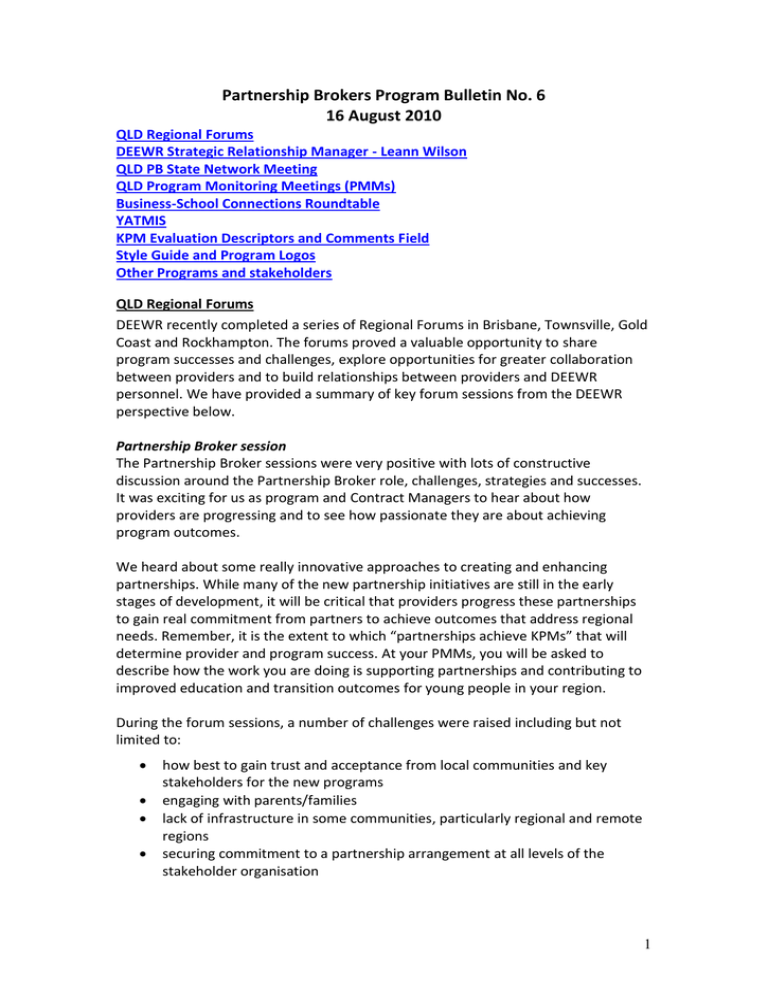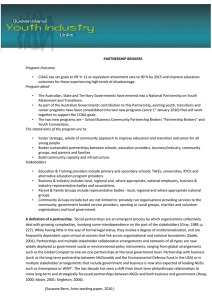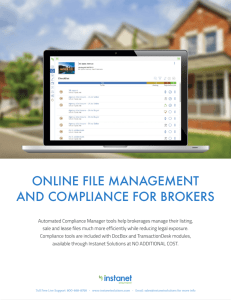Partnership Brokers Program Bulletin No. 6 16 August 2010
advertisement

Partnership Brokers Program Bulletin No. 6 16 August 2010 QLD Regional Forums DEEWR Strategic Relationship Manager - Leann Wilson QLD PB State Network Meeting QLD Program Monitoring Meetings (PMMs) Business-School Connections Roundtable YATMIS KPM Evaluation Descriptors and Comments Field Style Guide and Program Logos Other Programs and stakeholders QLD Regional Forums DEEWR recently completed a series of Regional Forums in Brisbane, Townsville, Gold Coast and Rockhampton. The forums proved a valuable opportunity to share program successes and challenges, explore opportunities for greater collaboration between providers and to build relationships between providers and DEEWR personnel. We have provided a summary of key forum sessions from the DEEWR perspective below. Partnership Broker session The Partnership Broker sessions were very positive with lots of constructive discussion around the Partnership Broker role, challenges, strategies and successes. It was exciting for us as program and Contract Managers to hear about how providers are progressing and to see how passionate they are about achieving program outcomes. We heard about some really innovative approaches to creating and enhancing partnerships. While many of the new partnership initiatives are still in the early stages of development, it will be critical that providers progress these partnerships to gain real commitment from partners to achieve outcomes that address regional needs. Remember, it is the extent to which “partnerships achieve KPMs” that will determine provider and program success. At your PMMs, you will be asked to describe how the work you are doing is supporting partnerships and contributing to improved education and transition outcomes for young people in your region. During the forum sessions, a number of challenges were raised including but not limited to: how best to gain trust and acceptance from local communities and key stakeholders for the new programs engaging with parents/families lack of infrastructure in some communities, particularly regional and remote regions securing commitment to a partnership arrangement at all levels of the stakeholder organisation 1 how to improve coordination between Partnership Broker priorities for partnership development and the objectives/priorities of other key regional planning processes such as DYAP and/or Catholic and Independent school system plans and programs how best to engage with the various state government departments, including DET and the government school system. changes to responsibilities for the provision of Structured Workplace Learning (SWL) placements and managing the expectation that Partnership Brokers can provide this service. The following list includes some of the successful strategies that Partnership Brokers are employing, as well as advice from key stakeholders who attended the forums: gain the support of a trusted community member to give you and the program credibility understand and clearly explain the objectives of the YAT National Partnership, the QLD Implementation Plan and the Partnership Broker program, highlighting aspects most relevant to the audience when engaging with a new community/stakeholder, take something that will illustrate the potential benefits of engaging with the program. For example, use a success story to show how others, like them, have benefited through partnering use the power of the network and explore the many different strategies being implemented by Partnership Brokers in other regions across Australia work collaboratively with other organisations and service providers operating in the community connect with local councils to leverage off local initiatives and influence regional planning QLD TAFEs are reducing the availability of Certificate II courses which may present partnership opportunities involving schools that will be looking to increase their capacity to deliver such courses use Youth Connections and Partnership Broker state networks to engage with state level peaks and representative bodies. use the lack of SWL provision as an opportunity to assist schools and their community to revisit the value and purpose of previous VET activity and develop partnerships that gain commitment from schools and business to implement sustainable outcomes. Youth Connections session Regional Forums offered a great opportunity for Youth Connections providers to connect, engage and share ideas. It is evident that providers have worked hard to ensure that the program is accepted in communities across the state. We recognise your efforts and the progress the program is making in meeting the needs of rural, remote and metropolitan communities across QLD. Discussion at the forums included operational issues such as relationships with school principals, working with Indigenous Australians as well as culturally and 2 linguistically diverse young people, program concurrency and the lack of support services in regional and remote areas. Transport and infrastructure issues continue to affect all regions as do gaps in support services and the lack of safe, affordable, ongoing accommodation for homeless young people and families in crisis. The Youth Connections sessions were an opportunity to focus on successes and challenges, brainstorm solutions and share best-practice. Unmet demand is emerging as a key issue that will confront providers over the next few months. We recognise that high demand for services means that some providers will face difficult decisions in regards to caseloads: prioritising need, management of excess referrals and when to exit a participant. The challenge of a lack of infrastructure or support specifically for 13–15 year olds was identified across most regions. Some of the concerns were: limited or no alternative suitable learning opportunities for these young people not all TAFEs are structured or appropriately resourced to work with this cohort of young people QLD TAFEs are reducing the availability of Certificate II courses few schools are equipped to deliver the full range of Certificate II courses as an alternative learning pathway and engagement strategy lack of infrastructure and youth support services in regional and remote communities. A number of innovative and locally relevant solutions are being implemented by YC providers to tackle these issues including: partnering with existing education and training services arranging mentoring support for 13-15 year olds attending TAFE programs working collaboratively with YSCs and other youth support providers. Many of the issues raised require the sort of systemic change that could be delivered through Type 4 services and we encourage you to continue to work collaboratively and share best practice with each other. The state network will be an important mechanism for addressing state-wide program challenges and identifying solutions. Joint Youth Connections and PB session – Type 4 Services During the joint Youth Connections and Partnership Brokers sessions we saw more variation in the level of collaboration between providers than we had anticipated. Congratulations to those of you who have been working closely in a strategic way to remove the systemic barriers affecting at risk young people in your Service Region. We look forward to hearing more about the results of your collaboration during the upcoming Program Monitoring Meetings (PMMs). As you know, delivery of Type 4 Services can involve Youth Connections and Partnership Broker providers working together to strengthen services for at risk 3 young people and ensuring that providers of other services in a region are connected through partnership arrangements. During the joint sessions, we observed three broad stages of relationship development between Partnership Brokers and Youth Connections providers: 1. Youth Connections and Partnership Broker providers are working together to strengthen services by exploring new or enhanced partnership arrangements to meet an identified need in the region. 2. Youth Connections and Partnership Broker providers who are working closely together and sharing information but are yet to implement strategies. 3. Little connection has been made between the Youth Connections and Partnership Broker providers. We will be discussing the level and nature of collaboration between Youth Connections and Partnership Broker providers in more detail at upcoming PMMs to ensure that you are working together to maximise program outcomes. For more information on working together please refer to: PB Guidelines - section 3.6 Youth Connections Providers; and Youth Connections Guidelines - section 5.3 Partnerships with School Business Community Partnership Brokers. DEEWR Strategic Relationship Manager QLD - Leann Wilson Providers who attended the regional forum in Rockhampton will have met Leann Wilson. We would like to introduce Leann Wilson to all our providers so that they can tap into her expertise should they need it. Leann is the Department's Strategic Relationships Manager. She represents and promotes awareness of the Department’s commitment to Closing the Gap in disadvantage between Indigenous and non-Indigenous Australians. Her role is to assist in brokering innovative strategic solutions to accelerate effort to meet the education, training and employment needs of Indigenous people. Part of her role is also to explore opportunities for improved program coordination and flexibility, cultivating productive relationships with key stakeholders including Indigenous communities and other government and non-government agencies. Leann can be contacted on (07) 4930 8136 or 0419 604 942. QLD PB State Network Meeting The first Queensland Partnership Broker State Network face-to-face meeting was held in Brisbane on 2 August 2010. Delegates from each Partnership Broker organisation attended the workshop. Angela Kitzelman from the QLD Department of Education and Training provided an overview on the status of the QLD YAT National Partnership Implementation Plan. 4 The agenda for the day included clarifying the intent and purpose of the State Network, analysis of delegates’ skills and strengths, identifying roles and expectations, as well as developing work plans and task allocation. The minutes of the meeting have been distributed. We will work with the Network to progress relevant program issues at the upcoming YAT Advisory Committee meeting, scheduled for early September. QLD Program Monitoring Meetings (PMMs) The Department is currently scheduling annual Program Monitoring Meetings with Partnership Brokers throughout August to early October 2010. Local Contract Managers are in the process of contacting individual providers regarding suitable dates to meet. These meetings will focus on working together with providers to gather information to support ongoing program improvement. The PMMs represent the major annual contact with the Department and involve discussion about the: nature of the environment that providers are operating in including their region’s challenges and opportunities provider’s performance and progress towards achieving program outcomes challenges and successes for the provider that could contribute to the broader Partnership Broker network ways DEEWR can better support providers to achieve program outcomes. Business-School Connections Roundtable The Business-School Connections Roundtable recently released its discussion paper, and is now commencing its consultation phase. The consultation phase includes a number of elements: key stakeholder meetings consultation workshops specific consultations with young people written submissions. The consultation workshops are scheduled to take place in September 2010. These workshops are intended to bring the various stakeholder groups together to discuss questions raised in the Roundtable’s discussion paper and to develop specific ideas which could help to ensure that all schools can benefit from a connection with business. A copy of the Roundtable’s discussion paper is available on the BusinessSchool Connections Roundtable webpage at http://www.deewr.gov.au/BSCRoundtable. The Roundtable is also inviting stakeholders to provide written submissions by 24 September in response to their discussion paper. We have written to the Chairs of the Partnerhip Brokers National and State Networks, encouraging the National Network to coordinate a submission on behalf of all Partnerhip Brokers providers. If State Networks or individual providers want to put forward a separate submission on local issues, this is at their discretion. 5 YATMIS Naming conventions for ‘Actions’ and the Information Privacy Principles Through the 'Organisations' module on YATMIS, system users are able to view all the 'Actions' that an organisation has been involved in. Partnership Brokers should ensure that they use naming conventions that do not identify individuals when naming an ‘Action’. If a Partnership Broker identifies an individual in the name of an ‘Action’ without their permission, the situation could be considered a breach of the Information Privacy Principles. Note: This advice applies only to the ‘Name’ of an ‘Action’. The ‘Description’ and other information associated with the ‘Action’ are only visible to the Partnership Broker that created the ‘Action’. KPM Evaluation Descriptors and Comments Field Evaluation descriptors We would like to thank the Partnership Broker providers who have given us feedback in regard to the KPM evaluation descriptors. These descriptors are used to indicate each partnership’s progress against KPMs. In early August, we updated the descriptors to better reflect the developmental nature of the KPMs. The new descriptors are as follows: Previous YATMIS KPM descriptors Updated YATMIS KPM descriptors 1. 2. 3. 4. 5. 1. 2. 3. 4. 5. Poor Below average Average Good Excellent Limited progress Some progress Satisfactory progress Considerable progress Achieved The messages displayed when a user hovers their cursor over the descriptors have also been updated to: 1. 2. 3. 4. 5. Limited progress has been made against this KPM to date Some progress has been made against this KPM Satisfactory progress has been made against this KPM Considerable progress has been made toward the achievement of this KPM This KPM has been achieved Comments field The 'Comments' associated with a particular KPM evaluation must provide a justification for each rating and may include qualitative and quantitative information that describes to what extent the KPM has been met. 6 Style Guide and Program Logos The Department has developed a Style Guide which includes a set of logos and marketing templates for Youth Attainment and Transitions and the Youth Connections and Partnership Brokers programs. All providers will receive a CD in the mail towards the end of this month which will include an electronic copy of the Style Guide, pre-populated factsheets and design files for all of the marketing templates. The Style Guide and pre-populated fact sheets will also be made available on YATMIS. It is not mandatory for providers to use these resources. It is up to individual providers to decide what type of materials they would like to produce and use in their region. We advised earlier in the year that while the branding was under development, providers could develop their own materials to raise awareness of the programs in their region. It is not necessary for providers to discontinue using those materials. Other Programs and stakeholders This regular section of the Bulletin contains information about other programs, initiatives and stakeholders relevant to your work as a Partnership Broker. We encourage Partnership Brokers to complement, and where appropriate to leverage off relevant programs. Career Development Association of Australia (CDAA) The Career Development Association of Australia (CDAA) is a national organisation of practitioners who work in the career development industry either for themselves or others, providing a range of career services for people entering the workforce, managing their work and life roles, or changing careers. Members work in a range of settings, including small to medium businesses, education, employment, rehabilitation, corporations, human resources, government service and community. Members provide a range of services for people who are: Seeking course and career information and advice Entering or re-entering the workforce Changing careers Undertaking job search and preparation activities Wanting assistance to manage their work and life roles. For further information, visit the CDAA website at: http://www.cdaa.org.au/ 2010 Australian Youth Mentoring Conference The Australian Youth Mentoring Network is holding a Youth Mentoring Conference from 10 - 11 November 2010 at the Gold Coast Radisson Resort. A renowned mentoring expert, Professor David DuBois Ph.D. will be the keynote speaker at the conference. 7 David DuBois is an Associate Professor in the Division of Community Health Sciences within the School of Public Health at the University of Illinois at Chicago. He has authored numerous peer-reviewed studies of youth mentoring and is the editor of The Handbook on Mentoring. This year's conference theme is ‘Collaboration. Guidance. Expertise.’ Anyone with an interest in youth mentoring practice and theory including, but not limited to, mentoring program coordinators, managers, teachers, principals youth workers, social workers, academics, sociology researchers, policy writers, and volunteer mentors are welcome to attend the conference. For more information about the Australian Youth Mentoring Network please visit http://www.youthmentoring.org.au/events/?catID=25 8

